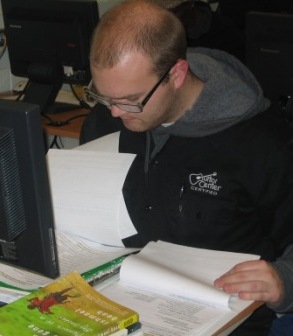|
|
|
Chapter
26. SUMMARY
Introduction
Basics
Advanced
Samples
Activities
---
Activities Using
Formal Summarizing
See also "Activities
& Groups." ---
SPECIAL ACTIVITIES
-
SUMMARY OF YOUR LIFE: Write a summary of your life. Keep it short--about
100-150 words.
-
SUMMARY OF GOOD MARRIAGE PARTNER: Write a 100-150 word summary of what you would like (or
do like) in a good marriage/life partner. Then gather in small groups,
share your summaries, and write a 100-150 word summary of your summaries.
-
BAD BOOK:
Imagine that you have just read a book that is
terribly written and with which you disagree strongly. Name the author,
title, and, in one sentence, the subject. Then write a 100-150 word
summary of its content without any reference to how poorly it is written, and
without any sign that you disagree with it.
-
JOB DESCRIPTION: In addition to summarizing texts, one can make summaries of people, events, jobs,
and businesses. Individually or in groups, make a summary of a job by creating a job
description for a newspaper "Wanted" ad. Then summarize the ideal person for it.
Then summarize the minimum requirements a person would have to meet to be hired.
-
INTERVIEW: Using the summaries in #1 above, interview one to two candidates from other groups.
Candidates should be allowed to see the job description and the minimum requirements (but
not necessarily the ideal-person summary) for a few minutes. During that time, the
interviewing group should plan the specific procedure for conducting its job interviews.
-
JOB DESIRABILITY: Summarize a job you have loved or hated, including normal and abnormal situations
and best and worst situations and conditions. Form groups based on types of jobs
summarized, and then in groups decide what level of desirability each job--as
described--has. List a few things that are right about each one and a few things that
could be changed about each one.
-
DATING SCENARIO: Write as much as you can for ten to fifteen minutes on the perfect person for you
to date or marry. Then, for four to seven minutes, summarize all you wrote in one-fourth
the sentences. Gather into small interest groups (e.g., "dating" people and
"marrying" people). Summarize for eight to twelve minutes all your summaries in just
several sentences for the whole group. Report back to class.
---
OTHER ACTIVITIES
-
THOUGHTS ABOUT THE CHAPTER:
As an individual or a group, read the chapter and take
notes about it using one or more of the methods in "General
Study Questions."
-
ROUGH DRAFT: As an individual or a group, write
a paper as described in this chapter. Use the subtitles
shown in the "Introduction" or the "Basics" section as
subtitles of your rough draft, and write at least 50+ words in each body
section. If you are working as a group, you may, if your instructor
allows, develop a fictional and fanciful background and subject for your
rough draft.
-
GROUP MAPPING & PLANNING: Divide into
small groups of 3-4 people randomly. In each group, one person each should
volunteer to be
(i) the facilitator (the person helping everyone to do the
work),
(ii) the writer/recorder (who does the writing for the group),
(iii) the reader/announcer (who reports
the group's works to the class), and
(iv) if there is a fourth, the timekeeper, the observer taking notes about the group's way of working,
and/or the "social encourager"--someone who finds questions to encourage quieter
members of the group.
The group should then follow these steps using a
timetable given by the instructor, either in a small, close circle with the
writer using pen or laptop, or at a segment of the whiteboard with the
writer using a marker:
(A) What is the key or essence of this type of paper? Brainstorm an
interesting, fun idea (serious or silly) to write about.
(B) Then look at the "map" or blocks of how to build this type of paper,
from introduction through the body sections to the conclusion. The
instructor can either project it on a screen or draw it on the board.
Then fill in the parts with 50-100 words for each main body section, and
20-50 for the intro and conclusion (depending on the instructor's
directions).
(C) If your instructor suggests this, add a good made up illustration,
graphic, or quotation or two to each section from an "expert" and give
credit to your made-up expert. (Note: Never add made-up detail or
experts to a real paper.)
(D) Have your reader/announcer read your result to the entire class.
(E) After all groups have gone, then the "observer" in each group--or the
facilitator--should answer three brief comments on how the group process
happened: "What worked well," "What didn't," and "How could it be changed?"
-
GROUP CRITIQUE OF A
LATER DRAFT:
If your class has a paper all of you are preparing for grading, gather in a group to
critique each other's developed drafts:
(A) Simply pass the papers to each other;
your paper preferably should be checked by three other people. (Some
instructors prefer that you make several copies, distribute them to your
group members, take the copies home that you receive, and comment on them
there.)
(B) Write comments for each other.
To do so, use a a
set of grading guidelines (or "rubric"):
for example, "How are the contents,"
"How is the organization of parts," "Do paragraphs work
well," and "How well have editing errors been corrected?"
Preferably, you can use the guidelines your instructor applies when grading.
(C) For each question or requirement in your guidelines, write one or more
comments. Your comments should be substantial and specific (more like a
complete sentence, and more specific than just "Nice!" or "Needs
work"). Your comments also should be positive or helpfully
constructive: when positive, they should offer specific praise of a particular part, detail, or
method; when constructive, they should offer specific advice about what to add or do to make
the paper better.
(D) Add a final positive or constructive comment about how you think the
average reader of this paper might respond to it, and/or how the paper could
be changed or fixed for a stronger or more positive response from its
audience.
(E) After
receiving your comments from others, take them home. Review
what they have written. Remember
that your readers are not commenting on you as a person, but rather on how
easily (or poorly) they have been able to read your paper as its audience
members. Pay attention in particular to comments that may have
been repeated by more than one of your readers.
-
For a wide variety of other activities and
exercises, go to "Activities
& Groups."
---
Return to top. |
|

Related Chapters/Sections:
Basic Layouts to Summarize
Research Writing
---
Related
Links in
OnlineGrammar.org:
3.
Thinking & Reading
12. Types of Papers
14. Online Readings
16. Research Writing
|

